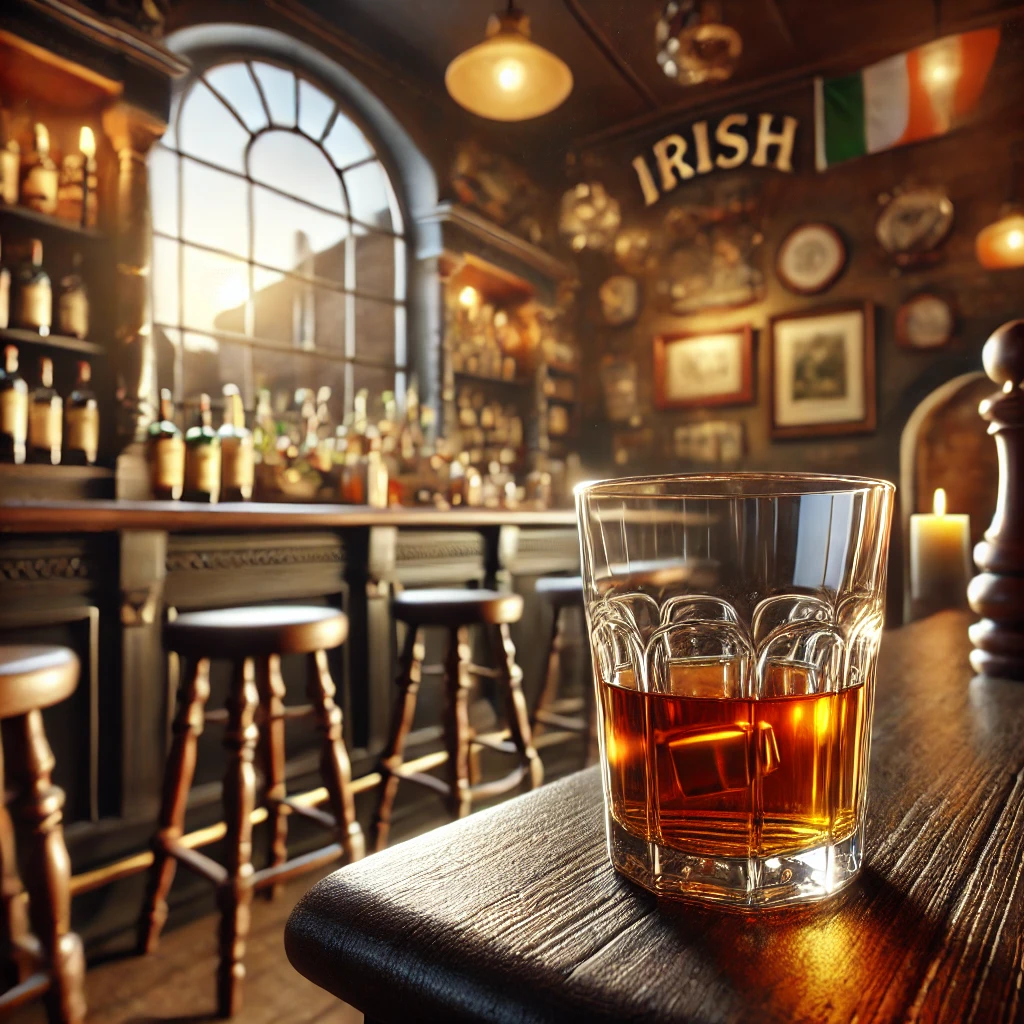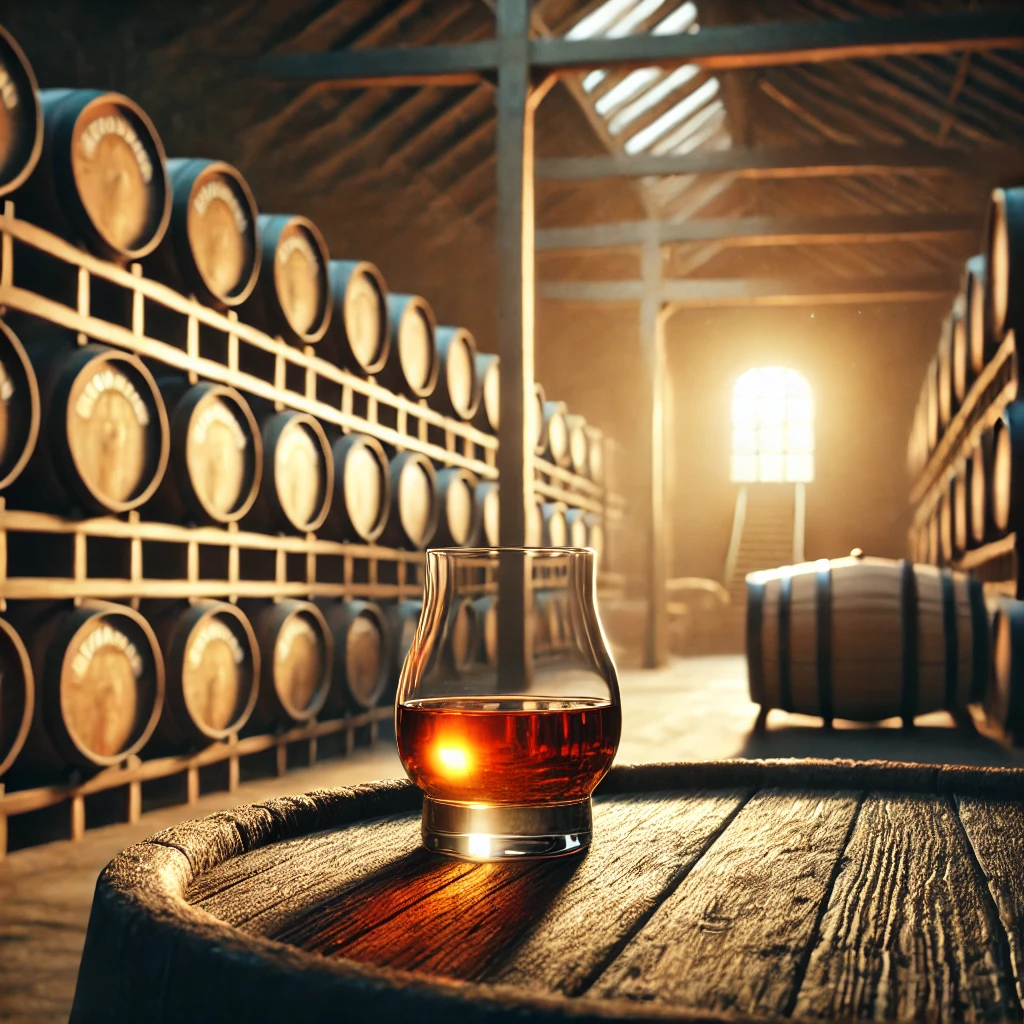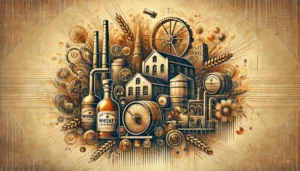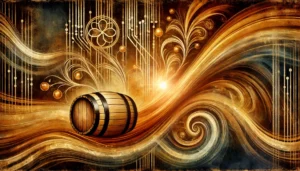Whiskey, a spirit with a rich history and diverse range of flavors, has captivated enthusiasts around the globe for centuries. Among the many types of whiskey, Irish whiskey stands out for its smooth, light character and deep cultural roots. As we delve into a comprehensive comparison between Irish whiskey and other world whiskeys, we’ll explore the unique qualities and intricate details that set each variety apart. From the rolling green hills of Ireland to the misty Scottish Highlands, and from the vibrant distilleries of the United States to the meticulously crafted Japanese blends, this journey will reveal the distinct charm and complexity of each whiskey type. Join us as we uncover the fascinating world of whiskey and celebrate the art of distillation that brings these spirits to life.
Introduction to Irish Whiskey and Global Whiskeys
Irish whiskey, renowned for its smooth and approachable flavor, has a history that stretches back over a thousand years. Often triple-distilled and made from a blend of malted and unmalted barley, Irish whiskey boasts a distinctive lightness and purity. Major players in the industry, such as Jameson, Bushmills, and Redbreast, have contributed significantly to its global reputation.
On the other hand, whiskey production is a global phenomenon, with significant contributions from regions such as Scotland, the United States, Japan, and Canada. Each of these regions brings unique methods, ingredients, and cultural influences to the table, resulting in a diverse and rich array of whiskey types. Scottish whisky, or Scotch, is famous for its peaty, smoky flavors, while American Bourbon is celebrated for its sweet, robust profile. Japanese whiskey, with its meticulous attention to detail, often mirrors Scotch but with a distinctive elegance and balance.
Production Processes: Ireland vs. the World
The production processes of Irish whiskey and its global counterparts are key to understanding their unique characteristics. Irish whiskey is typically triple-distilled, which contributes to its smoothness and clarity. The use of both malted and unmalted barley gives it a unique flavor profile, and the aging process in oak casks for at least three years adds to its complexity.
In contrast, Scotch whisky can be either single malt or blended and is usually double-distilled. The distinct smoky flavor of many Scotch whiskies comes from drying the malted barley over peat fires. Bourbon, primarily produced in the United States, must be made from at least 51% corn and aged in new charred oak barrels, imparting a rich, caramel sweetness. Japanese whiskey often draws inspiration from Scotch, using similar techniques but incorporating local ingredients and precise craftsmanship to create a refined, balanced spirit.
Flavor Profiles and Tasting Notes
Irish whiskey is known for its smooth, light, and slightly sweet flavor profile, with notes of vanilla, honey, and toasted wood. The triple-distillation process and use of unmalted barley contribute to its gentle and clean taste, making it a favorite for both newcomers and seasoned whiskey drinkers.
Scotch whisky offers a broad range of flavors, from the peaty and smoky notes of Islay whiskies to the rich, fruity, and sherried profiles of Speyside. Bourbon is characterized by its full-bodied, sweet flavors, often with hints of vanilla, caramel, and oak. Japanese whiskey tends to be smooth and well-balanced, with subtle complexities that can include floral, fruity, and smoky notes.

Cultural and Regional Influences
The cultural and regional influences on whiskey production are profound. In Ireland, whiskey-making is deeply intertwined with the country’s history and traditions, often celebrated in literature and song. Scottish whisky is shaped by the rugged landscapes and climate, with each region imparting its unique characteristics to the spirit. American Bourbon reflects the pioneering spirit and diverse agricultural heritage of the United States, while Japanese whiskey is a testament to the country’s dedication to precision and artistry.
Market Trends and Popularity
In recent years, Irish whiskey has experienced a resurgence in popularity, with increased global demand and a growing number of distilleries. The versatility and approachability of Irish whiskey have helped it gain a broad consumer base. Scotch whisky remains a staple in the whiskey market, with a strong presence in both traditional and emerging markets. Bourbon continues to grow in popularity, driven by a renewed interest in craft spirits and artisanal production methods. Japanese whiskey, once a niche product, has gained international acclaim for its quality and innovation, attracting a dedicated following.
Production Processes: Ireland vs. the World
The journey from grain to glass is a meticulous process that defines the character and quality of whiskey. In this section, we will delve into the production methods of Irish whiskey and compare them with those of other major whiskey-producing regions.
Irish Whiskey Production
- Ingredients and Mashing: Irish whiskey primarily uses a mix of malted and unmalted barley. The grains are mashed and mixed with hot water to extract fermentable sugars, creating a liquid called wort.
- Fermentation: The wort is then fermented using yeast, which converts the sugars into alcohol. This process typically takes around 48 to 96 hours and results in a beer-like liquid called wash.
- Distillation: One of the most distinguishing features of Irish whiskey is its triple-distillation process. The wash is distilled three times in copper pot stills, which helps to remove impurities and create a smoother spirit. This is in contrast to the double-distillation process commonly used in Scotch production.
- Aging: Irish whiskey must be aged for a minimum of three years in wooden casks, often made from oak. This aging process allows the whiskey to develop its flavors and character. The climate in Ireland, with its mild temperatures and high humidity, contributes to a slower and more even maturation process.
- Blending: Many Irish whiskeys are blends, combining single malt whiskey with grain whiskey to achieve a balanced and consistent flavor profile.
Scotch Whisky Production
- Ingredients and Mashing: Scotch whisky typically uses malted barley, with the notable exception of grain whisky, which can include other grains. The barley is dried over peat fires in some regions, imparting a smoky flavor.
- Fermentation: Similar to Irish whiskey, the wort is fermented to create wash. However, the fermentation period can vary, influencing the final flavor.
- Distillation: Scotch whisky is usually distilled twice in pot stills, although some distilleries may distill more than twice. This double distillation results in a heavier, more robust spirit compared to the triple-distilled Irish whiskey.
- Aging: Scotch must also be aged for at least three years, with many whiskies aged much longer. The aging process in oak casks, often previously used for sherry or bourbon, contributes to the whisky’s complexity.
- Types of Scotch: There are several types of Scotch whisky, including single malt, single grain, blended malt, blended grain, and blended Scotch whisky. Each type has distinct production methods and flavor profiles.
Bourbon Production
- Ingredients and Mashing: Bourbon must be made from at least 51% corn, with the remainder typically being a mix of barley, rye, and wheat. The grains are mashed and cooked to release sugars.
- Fermentation: The mash is fermented using yeast, producing a beer-like substance called distiller’s beer or wash.
- Distillation: Bourbon is usually distilled in column stills, resulting in a high-proof distillate. This process differs significantly from the pot still distillation used for Irish whiskey and Scotch.
- Aging: Bourbon must be aged in new charred oak barrels, which impart a distinct caramel and vanilla flavor. The aging process is often shorter than that of Scotch or Irish whiskey due to the more intense interaction with the wood in the charred barrels.
- Legal Requirements: There are strict regulations governing the production of Bourbon, including the requirement that it be produced in the United States and aged for at least two years to be called straight Bourbon.

Japanese Whiskey Production
- Ingredients and Mashing: Japanese whiskey often uses malted barley and incorporates local grains. The mashing process is similar to that of Scotch and Irish whiskey.
- Fermentation: Fermentation times can vary, and some distilleries use unique yeast strains to develop distinct flavor profiles.
- Distillation: Japanese whiskey is typically distilled in pot stills, with a focus on precision and quality control. Some distilleries also experiment with different types of stills and distillation methods.
- Aging: Aging takes place in a variety of cask types, including American oak, sherry, and Japanese oak (mizunara), which adds unique flavors to the whiskey.
- Blending and Innovation: Japanese distilleries are known for their blending expertise, often creating intricate and balanced whiskeys. Innovation and attention to detail are hallmarks of Japanese whiskey production.
Flavor Profiles and Tasting Notes
Whiskey enthusiasts often revel in the nuanced flavors and aromas that distinguish each variety. In this section, we’ll explore the flavor profiles and tasting notes of Irish whiskey compared to other world whiskeys.
Irish Whiskey
Irish whiskey is celebrated for its smooth, light, and often slightly sweet profile. The triple-distillation process and the use of both malted and unmalted barley contribute to a clean and refined spirit. Here are some key tasting notes:
- Nose: Aromas of vanilla, honey, and fresh fruit are common, often accompanied by subtle floral notes.
- Palate: The flavor is typically smooth and light, with hints of vanilla, caramel, and toasted wood. Some varieties may also have a slight spice or nutty undertone.
- Finish: The finish is usually clean and crisp, leaving a gentle warmth with lingering sweetness.
Scotch Whisky
Scotch whisky, with its diverse regional styles, offers a broad spectrum of flavors. Here are some general characteristics based on different regions:
- Islay: Known for its bold, peaty, and smoky flavors. Common notes include seaweed, iodine, and earthy peat.
- Speyside: Typically rich and fruity, with flavors of apple, pear, and dried fruits, often with a sherried sweetness and hints of vanilla and oak.
- Highland: A diverse range, from light and floral to rich and robust. Common flavors include heather, honey, and a slight smokiness.
- Lowland: Generally lighter and more delicate, with grassy, citrus, and floral notes.

Bourbon
Bourbon, predominantly produced in the United States, is characterized by its sweet and robust profile. Key tasting notes include:
- Nose: Rich aromas of caramel, vanilla, and sweet corn, often with hints of baking spices like cinnamon and nutmeg.
- Palate: Full-bodied and sweet, with flavors of caramel, toffee, and vanilla, complemented by oak and a touch of spice.
- Finish: The finish is usually warm and lingering, with a sweet, oaky aftertaste.
Japanese Whiskey
Japanese whiskey, inspired by Scotch but distinct in its own right, is known for its precision and balance. Typical tasting notes include:
- Nose: Delicate and complex, with aromas of fruit, floral notes, and a subtle smokiness.
- Palate: Smooth and balanced, with flavors of honey, vanilla, and sometimes a hint of green tea or citrus. The use of mizunara oak can impart unique spice and incense-like notes.
- Finish: Clean and elegant, often with a lingering sweetness and a hint of oak.
Cultural and Regional Influences
The cultural and regional influences on whiskey production profoundly shape its character and identity. Let’s delve into how geography and traditions impact whiskey-making in different regions.
Irish Whiskey
Irish whiskey is deeply rooted in Ireland’s history and culture. The country’s lush landscapes and mild climate provide ideal conditions for barley cultivation. The tradition of triple distillation, dating back centuries, reflects a commitment to producing a smooth and approachable spirit. Irish whiskey is often enjoyed in social settings, celebrating camaraderie and storytelling, which are integral parts of Irish culture.
Scotch Whisky
Scotland’s rugged terrain and variable climate contribute significantly to the distinct characteristics of Scotch whisky. Each region, from the peaty Islay to the fruity Speyside, imparts unique flavors influenced by local geography and climate. The use of peat in drying barley, especially in Islay, adds a smoky complexity to the whisky. Scotch whisky is steeped in tradition, with many distilleries adhering to time-honored methods passed down through generations.
Bourbon
Bourbon production is deeply intertwined with American history and agriculture. The use of corn as a primary ingredient reflects the abundant corn crops in the United States. The charred oak barrels used for aging bourbon add distinctive caramel and vanilla notes. Bourbon is often associated with the American South and is celebrated for its bold, sweet flavors that resonate with the spirit of American ingenuity and craftsmanship.
Japanese Whiskey
Japanese whiskey production is characterized by meticulous attention to detail and a focus on harmony and balance. The Japanese climate, with its hot summers and cold winters, influences the aging process, creating unique flavor profiles. The use of mizunara oak barrels adds distinctive spicy and incense-like notes to the whiskey. Japanese whiskey-making embodies a blend of tradition and innovation, reflecting the Japanese ethos of craftsmanship and precision.
Market Trends and Popularity
Whiskey markets worldwide are dynamic and constantly evolving. Let’s explore the current trends and consumer preferences for Irish whiskey and its global counterparts.
Irish Whiskey
Irish whiskey has experienced a renaissance in recent years, with a surge in global demand. The versatility and smoothness of Irish whiskey have broadened its appeal, attracting both new and seasoned whiskey drinkers. The growth of boutique distilleries and innovative expressions has further fueled its popularity. Major markets for Irish whiskey include the United States, the United Kingdom, and emerging markets in Asia.
Scotch Whisky
Scotch whisky remains a dominant force in the global whiskey market. Its diverse range of styles and high-quality reputation continue to attract a dedicated consumer base. Emerging markets in Asia, particularly China and India, have shown increasing interest in Scotch whisky. The trend towards premium and rare expressions has also boosted the market, with collectors and enthusiasts seeking out limited editions and aged whiskies.
Bourbon
Bourbon’s popularity has surged, driven by a renewed interest in craft spirits and artisanal production methods. The rise of craft distilleries and experimental expressions has expanded the bourbon market. The United States remains the largest market for bourbon, but international demand is growing, particularly in Europe and Asia. The trend towards high-proof and single-barrel bourbons reflects a consumer preference for bold and unique flavors.
Japanese Whiskey
Japanese whiskey has garnered international acclaim for its quality and innovation. The meticulous production methods and unique flavor profiles have attracted a global following. Limited availability and high demand have made some Japanese whiskeys highly sought after and collectible. Major markets for Japanese whiskey include the United States, Europe, and Asia, with increasing interest from whiskey enthusiasts and connoisseurs.
Cultural and Regional Influences
The cultural and regional influences on whiskey production profoundly shape its character and identity. Let’s delve into how geography and traditions impact whiskey-making in different regions.
Irish Whiskey
Irish whiskey is deeply rooted in Ireland’s history and culture. The country’s lush landscapes and mild climate provide ideal conditions for barley cultivation. The tradition of triple distillation, dating back centuries, reflects a commitment to producing a smooth and approachable spirit. Irish whiskey is often enjoyed in social settings, celebrating camaraderie and storytelling, which are integral parts of Irish culture.
Scotch Whisky
Scotland’s rugged terrain and variable climate contribute significantly to the distinct characteristics of Scotch whisky. Each region, from the peaty Islay to the fruity Speyside, imparts unique flavors influenced by local geography and climate. The use of peat in drying barley, especially in Islay, adds a smoky complexity to the whisky. Scotch whisky is steeped in tradition, with many distilleries adhering to time-honored methods passed down through generations.
Bourbon
Bourbon production is deeply intertwined with American history and agriculture. The use of corn as a primary ingredient reflects the abundant corn crops in the United States. The charred oak barrels used for aging bourbon add distinctive caramel and vanilla notes. Bourbon is often associated with the American South and is celebrated for its bold, sweet flavors that resonate with the spirit of American ingenuity and craftsmanship.
Japanese Whiskey
Japanese whiskey production is characterized by meticulous attention to detail and a focus on harmony and balance. The Japanese climate, with its hot summers and cold winters, influences the aging process, creating unique flavor profiles. The use of mizunara oak barrels adds distinctive spicy and incense-like notes to the whiskey. Japanese whiskey-making embodies a blend of tradition and innovation, reflecting the Japanese ethos of craftsmanship and precision.

Market Trends and Popularity
Whiskey markets worldwide are dynamic and constantly evolving. Let’s explore the current trends and consumer preferences for Irish whiskey and its global counterparts.
Irish Whiskey
Irish whiskey has experienced a renaissance in recent years, with a surge in global demand. The versatility and smoothness of Irish whiskey have broadened its appeal, attracting both new and seasoned whiskey drinkers. The growth of boutique distilleries and innovative expressions has further fueled its popularity. Major markets for Irish whiskey include the United States, the United Kingdom, and emerging markets in Asia.
Scotch Whisky
Scotch whisky remains a dominant force in the global whiskey market. Its diverse range of styles and high-quality reputation continue to attract a dedicated consumer base. Emerging markets in Asia, particularly China and India, have shown increasing interest in Scotch whisky. The trend towards premium and rare expressions has also boosted the market, with collectors and enthusiasts seeking out limited editions and aged whiskies.
Bourbon
Bourbon’s popularity has surged, driven by a renewed interest in craft spirits and artisanal production methods. The rise of craft distilleries and experimental expressions has expanded the bourbon market. The United States remains the largest market for bourbon, but international demand is growing, particularly in Europe and Asia. The trend towards high-proof and single-barrel bourbons reflects a consumer preference for bold and unique flavors.
Japanese Whiskey
Japanese whiskey has garnered international acclaim for its quality and innovation. The meticulous production methods and unique flavor profiles have attracted a global following. Limited availability and high demand have made some Japanese whiskeys highly sought after and collectible. Major markets for Japanese whiskey include the United States, Europe, and Asia, with increasing interest from whiskey enthusiasts and connoisseurs.
Market Trends and Popularity
Whiskey markets worldwide are dynamic and constantly evolving. Let’s explore the current trends and consumer preferences for Irish whiskey and its global counterparts.
Irish Whiskey
Irish whiskey has experienced a renaissance in recent years, with a surge in global demand. The versatility and smoothness of Irish whiskey have broadened its appeal, attracting both new and seasoned whiskey drinkers. The growth of boutique distilleries and innovative expressions has further fueled its popularity. Major markets for Irish whiskey include the United States, the United Kingdom, and emerging markets in Asia.
Key trends in the Irish whiskey market include:
- Innovative Expressions: Distilleries are experimenting with new flavor profiles, cask finishes, and blends to attract a broader audience.
- Craft and Boutique Distilleries: The rise of small-scale distilleries producing unique, high-quality whiskeys is a significant trend.
- Sustainability: Increasing focus on sustainable production practices and eco-friendly packaging.
Scotch Whisky
Scotch whisky remains a dominant force in the global whiskey market. Its diverse range of styles and high-quality reputation continue to attract a dedicated consumer base. Emerging markets in Asia, particularly China and India, have shown increasing interest in Scotch whisky. The trend towards premium and rare expressions has also boosted the market, with collectors and enthusiasts seeking out limited editions and aged whiskies.
Key trends in the Scotch whisky market include:
- Premiumization: A growing demand for high-end, aged, and limited-edition whiskies.
- Single Malts: Increased popularity of single malt Scotch whiskies, known for their distinct regional characteristics.
- Sustainability and Innovation: Focus on sustainable practices and innovative production techniques, including new types of casks and finishes.
Bourbon
Bourbon’s popularity has surged, driven by a renewed interest in craft spirits and artisanal production methods. The rise of craft distilleries and experimental expressions has expanded the bourbon market. The United States remains the largest market for bourbon, but international demand is growing, particularly in Europe and Asia. The trend towards high-proof and single-barrel bourbons reflects a consumer preference for bold and unique flavors.
Key trends in the bourbon market include:
- Craft Distilling: The growth of small, independent distilleries producing high-quality, unique bourbons.
- High-Proof and Single-Barrel: Increasing interest in high-proof and single-barrel bourbons, offering distinctive flavors and profiles.
- Flavored Bourbons: Experimentation with different flavors, including honey, apple, and maple, to attract new consumers.
Japanese Whiskey
Japanese whiskey has garnered international acclaim for its quality and innovation. The meticulous production methods and unique flavor profiles have attracted a global following. Limited availability and high demand have made some Japanese whiskeys highly sought after and collectible. Major markets for Japanese whiskey include the United States, Europe, and Asia, with increasing interest from whiskey enthusiasts and connoisseurs.
Key trends in the Japanese whiskey market include:
- Limited Editions: High demand for limited-edition releases, often resulting in scarcity and high prices.
- Craftsmanship and Quality: Continued focus on high-quality production and attention to detail.
- Global Expansion: Growing export markets and international recognition, leading to increased availability worldwide.
Conclusion
In the world of whiskey, each variety offers a unique journey through history, culture, and craftsmanship. Irish whiskey, with its smooth and approachable character, stands as a testament to Ireland’s rich distilling tradition. The meticulous production processes and cultural influences that shape Irish whiskey set it apart on the global stage.
Meanwhile, Scotch whisky presents a broad spectrum of flavors, from the smoky and peaty to the rich and fruity, reflecting the diverse landscapes of Scotland. Bourbon, with its sweet, robust profile, captures the spirit of American innovation and tradition. Japanese whiskey, characterized by its precision and balance, showcases the artistry and dedication of its producers.
As global markets continue to evolve, whiskey enthusiasts are treated to an ever-expanding array of expressions and innovations. Whether you’re savoring the light elegance of an Irish whiskey, the bold complexity of a Scotch, the rich sweetness of a Bourbon, or the refined balance of a Japanese whiskey, there’s a world of flavors to explore and enjoy.
The resurgence and growing popularity of Irish whiskey, alongside the enduring appeal of Scotch, Bourbon, and Japanese whiskey, highlight the dynamic and exciting nature of the whiskey market. Each sip offers a taste of the region’s history, culture, and craftsmanship, making whiskey a truly global and timeless spirit.








Be First to Comment